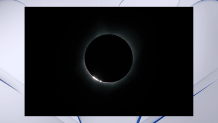If you were watching the 2024 solar eclipse, you might have noticed a burst of red at the bottom of the moon. What was it?
Turns out, it was something called a solar prominence.
According to NASA, a solar prominence "is a large, bright feature extending outward from the sun’s surface."
"Prominences are anchored to the Sun’s surface in the photosphere, and extend outwards into the Sun’s hot outer atmosphere, called the corona," NASA reported.
Feeling out of the loop? We'll catch you up on the Chicago news you need to know. Sign up for the weekly Chicago Catch-Up newsletter here.
Prominences are not typically visible with the naked eye, but a total solar eclipse offers a rare and narrow window for viewers to see one.
"These structures can often be seen as red or pink features during a total solar eclipse," according to EarthSky.
NBC 5 Storm Team Meteorologist Pete Sack said the "conditions were perfect to see solar activity, like coronal mass ejections," or CMEs, during the eclipse Monday.
Local
"The moon has to be at just the right distance away from Earth," Sack said. "If the moon is a little too close, the moon blocks out prominence. If it's a little too far away, the brightness of the corona obscures the solar activity. Conditions yesterday were perfect in every way possible," he said.
Sack was among those who witnessed totality live during the eclipse -- and has since gone viral for his emotional response to the once-in-a-lifetime sight.
And the solar prominence wasn't the only exciting phenomenon witnessed.
Just before totality began, those along the path were also able to see beads of sunlight shining through valleys and mountains on the edge of the moon. The effect has come to be known as Baily's Beads, in reference to the English astronomer who made the discovery.

The beads disappear until a single bright spot remains along the edge of the moon’s shadow. As the last bits of sunlight pass through the valleys on the moon's limb, the faint corona around the sun becomes visible, according to NASA.
That's when another fascinating display of light emerges, resembling a ring with glittering diamonds on it.

Once the diamond ring initially disappeared and there is no longer any direct sunlight, viewers were able to remove their eclipse glasses and look at the total eclipse safely with the naked eye.
As the moon continued to move across the face of the sun, viewers saw brightening on the opposite side from where the diamond ring emerged, according to NASA's website. That signaled the need to resume using eclipse glasses.



